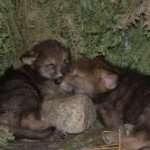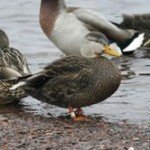By Dana Johnson
The raccoon is a common Minnesota resident. It is easily identified by its stout gray/brown body, striped tail, pointed nose, and of course its characteristic black mask.
Until recently, raccoons were not often seen in the northeastern Arrowhead region of Minnesota. A warming climate and, to a lesser extent, expanding farmland are speculated reasons for the move northward.
Raccoons generally weigh between 15 and 30 pounds, and measure 25 to 40 inches in length from the nose to the tip of the tail. Their paws are hand-like and well suited to climbing trees, as well as grasping and opening food containers.
Raccoons are generally nocturnal, but may be active night or day. They establish small home territories of a square mile or so, though fights between raccoons are rare and they often get along well in groups.
Raccoons are omnivorous, meaning they eat both meat and plant material. They are not picky and will consume almost anything, including whatever might be leftover in accessible trash cans in residential areas where they’ve adapted very well. Many northern Minnesota residents have reported raccoons visiting backyard birdfeeders. In the wild their diet consists mostly of berries, nuts, grains, insects and other invertebrates, small mammals, eggs, birds, fish, reptiles, and amphibians.
These
unique animals are known for their habit of “washing” their food, and will emulate this behavior in captivity as well, and will perform the motions even when there is no water. There has been much speculation as to why raccoons do this. One theory is the idea that raccoons have insufficient saliva glands and wetting food aids in digestion. Another claim infers that touch is this animal’s strongest sense, and by moistening its food it can get a better feel for whatever it plans to put into its mouth. Others believe that because raccoons prefer to live close to water sources and frequently consume aquatic creatures, it simply feels more natural for them to dip their food, or that they may be trying to attract other small, consumable creatures to them by waving their meal in the water. Still others speculate that this behavior removes dirt and sand from the raccoon’s food that may otherwise harm their teeth, or that their hand-like paws tenderize the meal to aid in digestion.
During the summer months raccoons are busy caring for their young and scavenging for food to build up fat for the winter. Raccoons are not true hibernators, but they will retire into burrows or tree cavities during the coldest days of the year, sometimes sleeping for a month at a time. They are active year round in warmer climates.





